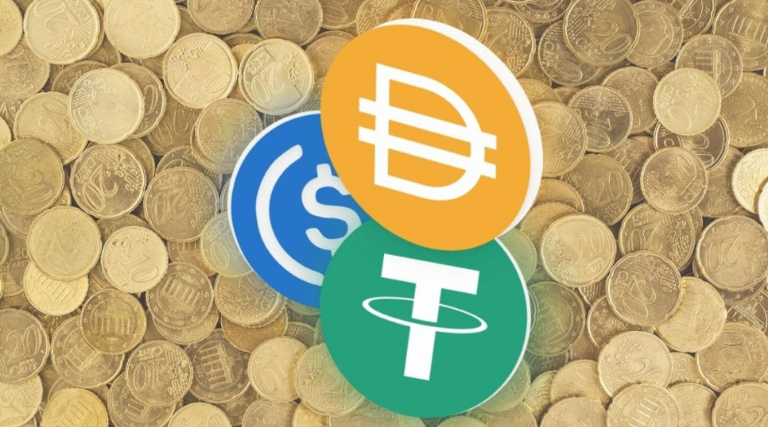More and more people are seeking out stable stores of value as hyperinflation wipes out the value of local currencies in countries like Argentina, Venezuela, and Turkey. Being the world reserve currency, and relatively stable in comparison to these other currencies, the US dollar usually fills this role.
The issue is that dollars are often tightly controlled by foreign governments, or in such great demand that citizens cannot get their hands on them. Taking this problem into consideration, what if dollars were to be digitized on an open and permissionless blockchain that everyone in the world had access to?
In this article we are going to discuss how the blockchain technology behind Bitcoin has opened up "stablecoins" to the entire world, and the reason why they will descend into irrelevancy in the coming years.

Bitcoin -> Ethereum -> Stablecoins
Bitcoin was the first open and permissionless blockchain, allowing anyone to trade BTC without having to worry about interference from banks or governments. Years later, smart people would see the potential of Bitcoin and innovate upon its code to develop more advanced blockchains, such as Ethereum.
Ethereum was another open and permissionless blockchain, with the added functionality that anyone could generate their own programmable token atop the platform. Since its inception, one of the major use cases of Ethereum has been the issuance of stablecoins, which are essentially digital tokens that represent US dollars outside the banking system.
There are several benefits to using stablecoins over a bank:
- International payments - transfer dollars to anyone, regardless of their physical location.
- Instant settlements - have the payment settled in seconds, instead of 3-5 business days.
- Avoid inefficiencies - the payment is peer-to-peer, and does not need to be approved by a bank.
- Stability within crypto - exit out of Bitcoin and other cryptocurrencies into the dollar during volatile market conditions, without involving a bank.
As a testament to their popularity, one of the most used stablecoins is USDT, which has already issued over 48 billion dollars worth of tokens on the Ethereum blockchain alone. USDT is a fiat-backed stablecoin that co-exists along with algorithmic stablecoins, like DAI. We'll cover the difference below, before discussing their fate.
Fiat-Backed Stablecoins
Companies that have issued fiat-backed stablecoins, like Tether (USDT) and Circle (USDC), are supposed to have an equivalent number of US dollars in the bank. Those dollars supposedly back the tokens they have issued on Ethereum and other blockchains. However, the accuracy of their claims has come into question several times in the past.
It's also worth mentioning that unlike algorithmic stablecoins, fiat-backed stablecoins are also susceptible to censorship, meaning the issuer could freeze the tokens associated with a particular Ethereum wallet if they were compelled to by an authority.
Algorithmic Stablecoins
As opposed to fiat-backed stablecoins, algorithmic stablecoins are backed by actual cryptocurrencies through the use of complex formulas. For example, in the case of MakerDAO, users deposit ETH as collateral to generate the stablecoin DAI, which can then be traded on open markets.

Although susceptible to flaws in the algorithm (remember Terra Luna's collapse), algorithmic stablecoins are unregulated and less vulnerable to censorship. Both fiat-back and algorithmic stablecoins have gained significant worldwide adoption in recent years, as inflation worsens around the planet.
Stablecoins > Bitcoin
Bitcoin has always been a long-term hedge against inflation, but its price volatility relative to the US dollar has turned most people away from using crypto in their daily lives. However, now that dollars have been digitized on permissionless blockchains in the form of stablecoins, many people are using them to escape their hyperinflating local currencies. This will work until the US dollar itself starts to inflate exponentially.
Fiat Fiasco
Being the world reserve currency, the US dollar is still the most in-demand fiat currency worldwide, and therefore it is sinking at a slower rate compared to all the others. That said, the dollar continues to lose value relative to Bitcoin/crypto over the long run, and will eventually fail just like all of the others. As the saying goes, "it's the cleanest shirt in the dirty laundry basket", and for that reason a lot of people are still latching onto it.
With over a trillion dollars being tacked onto the US debt every three months, the USD is starting to lose value rapidly, and that is becoming evident in the prices we are paying for expenses like rent, food, and gasoline. Seeing the writing on the wall, nation after nation is beginning the process of de-dollarization, meaning they are dropping the dollar in favor of other currencies, including crypto.
Keep in mind that a stablecoin is merely a digital representation of the dollar. As inflation picks up pace due to de-dollarization, stablecoins will no longer be so "stable", and they will lose value relative to hard assets like gold, Bitcoin, and other cryptocurrencies. When fiat finally falls into a rapid descent, people will convert their stablecoins quickly into Bitcoin and other cryptocurrencies, which will become the money of the future.
Stablecoins Will Go Down With The Ship
The blockchain technology behind Bitcoin has given rise to permissionless stablecoins, which can be used by anyone in the world to make payments and avoid the inefficiencies of traditional banks. This blockchain use case is serving us well for the time being, but will be unnecessary when the fiat system finally fades into irrelevancy.
If you learned something from this post be sure to check out my other articles on finance and crypto here on the HIVE blockchain. You can also follow me on InLeo for more frequent updates.
Until next time...
Resources
Stablecoins image [1]
Complicated algorithms image [2]
Lark's tweet on inflation [3]